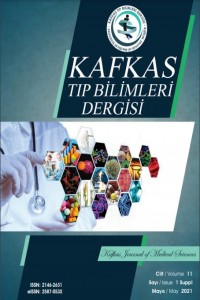Öz
Amaç: Acil tıp, zaman kullanımının verimli olması gereken en önemli hastane birimidir. Burada kaybedilen kısa bir süre bile hastaların hayatını tehlikeye atabilir. Bu birimde çalışanlar konsantrasyonlarını kaybetmemeli ve gelen hastaları çok dikkatli değerlendirmelidir. Ancak, bazı durumlarda çalışanların kesintiye uğradığı bilinmektedir. Örneğin, iş sırasında doktora gelen bir kısa mesaj, çalışmasını kesintiye uğratabilir. Literatürdeki araştırmalar, doktorların ve diğer acil servis çalışanlarının vardiyaları sırasında sıklıkla kesintiye uğradığını göstermektedir. Acil serviste görev yapan hekimlerin vardiyaları sırasında yaşadıkları kesintilerin belirlenmesi amaçlanmıştır. Bu kesintilerin nedenleri ve sonuçları da incelenmiştir.
Materyal ve Metot: Bu kesitsel bir gözlemsel çalışmadır. Acil serviste çalışan doktorlar çalışmaları sırasında iki araştırmacı tarafından izlenmiştir. Kesintinin nedenleri, kesinti süresi, zaman aralığı, acil servis doluluk oranı, doktorun kesinti sırasındaki yaptığı iş, kesinti yönetimi kaydedildi.
Bulgular: 21 doktor 72 saat boyunca gözlendi. Bu süre içinde doktorlar toplam 1975 kez kesintiye uğradı. Saatte 5,8 kesinti olduğu görüldü. Kesintilerim toplam süresi 469,05 dakikaydı. Çalışmada en yaygın kesinti nedeni telefon olarak bulunmuştur. Kesintiler genellikle doktorlar hastanın sonuçlarını incelerken oluştu.
Sonuç: Kesintiler acil servislerin temel sorunlarındandır ve tıbbi hataların ana faktörleri arasındadır. Doktorlar birden çok görevi aynı anda yapmamalı ve mevcut işlerini bitirdikten sonra bir diğer işe geçmelidirler.
Anahtar Kelimeler
Kaynakça
- 1. Söyük S, Kurtuluş SA. Acil servislerde yaşanan sorunların çalışanlar gözünden değerlendirilmesi. Gümüşhane Üniversitesi Sağlık Bilimleri Dergisi 2017;6(4):44–56.
- 2. Skaugset LM, Farrell S, Carney M, Wolff M, Santen SA, Perry M, et al. Can You Multitask? Evidence and Limitations of Task Switching and Multitasking in Emergency Medicine. Ann Emerg Med 2016;68(2):189–195.
- 3. Berg LM, Kallberg AS, Goransson KE, Ostergren J, Florin J, Ehrenberg A. Interruptions in emergency department work: an observational and interview study. BMJ Qual Saf 2013;22(8):656–663.
- 4. Chisholm CD, Dornfeld AM, Nelson DR, Cordell WH. Work interrupted: a comparison of workplace interruptions in emergency departments and primary care offices. Ann Emerg Med 2001;38(2):146–151.
- 5. Kalisch BJ, Aebersold M. Interruptions and multitasking in nursing care. Jt Comm J Qual Patient Saf 2010;36(3):126–132.
- 6. Raban MZ, Westbrook JI. Are interventions to reduce interruptions and errors during medication administration effective?: a systematic review. BMJ Qual Saf 2014;23(5):414–421.
- 7. Baud D, Qi X, Nielsen-Saines K, Musso D, Pomar L, Favre G. Real estimates of mortality following COVID-19 infection. Lancet Infect Dis 2020;20(7):773.
Öz
Aim: Emergency medicine is the most important hospital unit where the time usage should be efficient. Even a little time lost here can endanger the lives of patients. Employees should not lose their concentration and evaluate patients who come very carefully. However, it should not be forgotten that employees are interrupted in some cases. For example, an incoming text message to the doctor at the time of service may interrupt his/her work. Researches in the literature show that doctors and other emergency service employees are frequently interrupted during their shifts.
Aim: It was aimed to determine the interruptions experienced by the physicians working in the emergency department during their shifts. The causes and consequences of these interruptions were also examined.
Material and Method: This is a cross-sectional observational study. The physicians working in the emergency room will be monitored during their work by two researchers. Causes of interruption, duration of interruption, time interval, emergency room occupancy rate, the doctor’s work during the interruption, management of the interruption was recorded. Results: 21 physicians were observed for 72 hours, physicians in the emergency services have been interrupted for 1975 times in 72 hours. It showed that there were 5.8 interruptions per hour. The total interruption was 469.05 minutes. The most common interruption reason has found as telephones in the study. Interruptions usually occurred when the doctors were examining the results of a patient.
Conclusion: Interruptions are one of the basic problems of the emergency services and they are the main factors of medical mistakes. The doctors should never try to be multi-tasked and they should respond the interruption after finishing their work.
Anahtar Kelimeler
Kaynakça
- 1. Söyük S, Kurtuluş SA. Acil servislerde yaşanan sorunların çalışanlar gözünden değerlendirilmesi. Gümüşhane Üniversitesi Sağlık Bilimleri Dergisi 2017;6(4):44–56.
- 2. Skaugset LM, Farrell S, Carney M, Wolff M, Santen SA, Perry M, et al. Can You Multitask? Evidence and Limitations of Task Switching and Multitasking in Emergency Medicine. Ann Emerg Med 2016;68(2):189–195.
- 3. Berg LM, Kallberg AS, Goransson KE, Ostergren J, Florin J, Ehrenberg A. Interruptions in emergency department work: an observational and interview study. BMJ Qual Saf 2013;22(8):656–663.
- 4. Chisholm CD, Dornfeld AM, Nelson DR, Cordell WH. Work interrupted: a comparison of workplace interruptions in emergency departments and primary care offices. Ann Emerg Med 2001;38(2):146–151.
- 5. Kalisch BJ, Aebersold M. Interruptions and multitasking in nursing care. Jt Comm J Qual Patient Saf 2010;36(3):126–132.
- 6. Raban MZ, Westbrook JI. Are interventions to reduce interruptions and errors during medication administration effective?: a systematic review. BMJ Qual Saf 2014;23(5):414–421.
- 7. Baud D, Qi X, Nielsen-Saines K, Musso D, Pomar L, Favre G. Real estimates of mortality following COVID-19 infection. Lancet Infect Dis 2020;20(7):773.
Ayrıntılar
| Birincil Dil | İngilizce |
|---|---|
| Konular | Klinik Tıp Bilimleri |
| Bölüm | Araştırma Makalesi |
| Yazarlar | |
| Yayımlanma Tarihi | 1 Mayıs 2020 |
| Yayımlandığı Sayı | Yıl 2021 Cilt: 11 Sayı: EK-1 |


